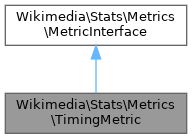Timing Metric Implementation. More...
Inherits Wikimedia\Stats\Metrics\MetricInterface.

Public Member Functions | |||||||
| __construct ( $baseMetric, $logger) | |||||||
| copyToStatsdAt ( $statsdNamespaces) | |||||||
Copies metric operation to StatsD at provided namespace.Takes a namespace or multiple namespaces.
| |||||||
| fresh () | |||||||
Returns metric with cleared labels.
| |||||||
| getComponent () | |||||||
| |||||||
| getLabelKeys () | |||||||
Returns the list of defined label keys.
| |||||||
| getName () | |||||||
| |||||||
| getSampleCount () | |||||||
Returns a count of samples recorded by the metric.
| |||||||
| getSampleRate () | |||||||
| |||||||
| getSamples () | |||||||
Returns subset of samples corresponding to sample rate setting.
| |||||||
| getTypeIndicator () | |||||||
| |||||||
| observe (float $value) | |||||||
| Records a previously calculated observation. | |||||||
| setLabel (string $key, string $value) | |||||||
| Adds a label $key with $value.Note that the order in which labels are added is significant for StatsD output.Example: $statsFactory->getCounter( 'testMetric_total' )
->setLabel( 'first', 'foo' )
->setLabel( 'second', 'bar' )
->increment();
statsd: "mediawiki.testMetric_total.foo.bar" prometheus: "mediawiki_testMetric_total{ first='foo', second='bar' }
| |||||||
| setSampleRate (float $sampleRate) | |||||||
Sets sample rate on a new metric instance.
| |||||||
| start () | |||||||
| Starts a timer. | |||||||
| stop () | |||||||
| Stops a running timer. | |||||||
 Public Member Functions inherited from Wikimedia\Stats\Metrics\MetricInterface Public Member Functions inherited from Wikimedia\Stats\Metrics\MetricInterface | |||||||
| __construct (BaseMetricInterface $baseMetric, LoggerInterface $logger) | |||||||
Detailed Description
Timing Metric Implementation.
Timing metrics track duration data which can be broken into histograms. They are identified by type "ms".
- Since
- 1.38
Definition at line 38 of file TimingMetric.php.
Constructor & Destructor Documentation
◆ __construct()
| Wikimedia\Stats\Metrics\TimingMetric::__construct | ( | $baseMetric, | |
| $logger ) |
Definition at line 59 of file TimingMetric.php.
Member Function Documentation
◆ copyToStatsdAt()
| Wikimedia\Stats\Metrics\TimingMetric::copyToStatsdAt | ( | $statsdNamespaces | ) |
Copies metric operation to StatsD at provided namespace.Takes a namespace or multiple namespaces.
- Parameters
-
string | string[] $statsdNamespaces
- Returns
- CounterMetric|GaugeMetric|TimingMetric|NullMetric
Implements Wikimedia\Stats\Metrics\MetricInterface.
Definition at line 169 of file TimingMetric.php.
◆ fresh()
| Wikimedia\Stats\Metrics\TimingMetric::fresh | ( | ) |
Returns metric with cleared labels.
- Returns
- CounterMetric|GaugeMetric|TimingMetric|NullMetric
Implements Wikimedia\Stats\Metrics\MetricInterface.
Definition at line 181 of file TimingMetric.php.
◆ getComponent()
| Wikimedia\Stats\Metrics\TimingMetric::getComponent | ( | ) |
- Returns
- string
Implements Wikimedia\Stats\Metrics\MetricInterface.
Definition at line 115 of file TimingMetric.php.
◆ getLabelKeys()
| Wikimedia\Stats\Metrics\TimingMetric::getLabelKeys | ( | ) |
Returns the list of defined label keys.
- Returns
- string[]
Implements Wikimedia\Stats\Metrics\MetricInterface.
Definition at line 152 of file TimingMetric.php.
◆ getName()
| Wikimedia\Stats\Metrics\TimingMetric::getName | ( | ) |
- Returns
- string
Implements Wikimedia\Stats\Metrics\MetricInterface.
Definition at line 110 of file TimingMetric.php.
◆ getSampleCount()
| Wikimedia\Stats\Metrics\TimingMetric::getSampleCount | ( | ) |
Returns a count of samples recorded by the metric.
- Returns
- int
Implements Wikimedia\Stats\Metrics\MetricInterface.
Definition at line 130 of file TimingMetric.php.
◆ getSampleRate()
| Wikimedia\Stats\Metrics\TimingMetric::getSampleRate | ( | ) |
- Returns
- float
Implements Wikimedia\Stats\Metrics\MetricInterface.
Definition at line 135 of file TimingMetric.php.
◆ getSamples()
| Wikimedia\Stats\Metrics\TimingMetric::getSamples | ( | ) |
Returns subset of samples corresponding to sample rate setting.
- Returns
- Sample[]
Implements Wikimedia\Stats\Metrics\MetricInterface.
Definition at line 125 of file TimingMetric.php.
◆ getTypeIndicator()
| Wikimedia\Stats\Metrics\TimingMetric::getTypeIndicator | ( | ) |
- Returns
- string
Implements Wikimedia\Stats\Metrics\MetricInterface.
Definition at line 120 of file TimingMetric.php.
◆ observe()
| Wikimedia\Stats\Metrics\TimingMetric::observe | ( | float | $value | ) |
Records a previously calculated observation.
Expects values in milliseconds.
- Parameters
-
float $value milliseconds
- Returns
- void
Definition at line 96 of file TimingMetric.php.
◆ setLabel()
| Wikimedia\Stats\Metrics\TimingMetric::setLabel | ( | string | $key, |
| string | $value ) |
Adds a label $key with $value.Note that the order in which labels are added is significant for StatsD output.Example:
statsd: "mediawiki.testMetric_total.foo.bar" prometheus: "mediawiki_testMetric_total{ first='foo', second='bar' }
- Parameters
-
string $key string $value
- Returns
- CounterMetric|GaugeMetric|TimingMetric|NullMetric
Implements Wikimedia\Stats\Metrics\MetricInterface.
Definition at line 157 of file TimingMetric.php.
◆ setSampleRate()
| Wikimedia\Stats\Metrics\TimingMetric::setSampleRate | ( | float | $sampleRate | ) |
Sets sample rate on a new metric instance.
- Parameters
-
float $sampleRate
- Returns
- CounterMetric|GaugeMetric|TimingMetric|NullMetric
Implements Wikimedia\Stats\Metrics\MetricInterface.
Definition at line 140 of file TimingMetric.php.
◆ start()
| Wikimedia\Stats\Metrics\TimingMetric::start | ( | ) |
◆ stop()
| Wikimedia\Stats\Metrics\TimingMetric::stop | ( | ) |
The documentation for this class was generated from the following file:
- includes/libs/Stats/Metrics/TimingMetric.php